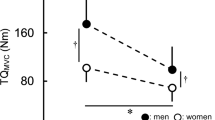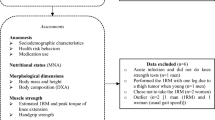Abstract
Background/Objectives
Muscle function is a marker of current and prospective health/independence throughout life. The effects of sex and obesity (OB) on the loss of muscle function in ageing remain unresolved, with important implications for the diagnosis/monitoring of sarcopenia. To characterise in vivo knee extensors’ function, we compared muscles torque and power with isometric and isokinetic tests in older men (M) and women (W), with normal range (NW) of body mass index (BMI) and OB.
Subjects/Methods
In 70 sedentary older M and W (69 ± 5 years), NW and OB (i.e. BMI < 30 kg m−2 and ≥30 kg m−2, respectively) we tested the right knee’s extensor: (i) isometric torque at 30°, 60°, 75° and 90° knee angles, and (ii) isokinetic concentric torque at 60, 90, 150, 180 and 210° s−1 angular speeds. Maximal isometric T–angle, maximal isokinetic knee-extensor torque–velocity, theoretical maximal shortening velocity, maximal power, optimal torque and velocity were determined in absolute units, normalised by body mass (BM) and right leg lean mass (LLMR) and compared over sex, BMI categories and angle or angular speeds by three-way ANOVA.
Results
In absolute units, relative to BM and LLMR, sex differences were found in favour of M for all parameters of muscle function (main effect for sex, p < 0.05). OB did not affect either absolute or relative to LLMR isometric and isokinetic muscle function (main effect for BMI, p > 0.05); however, muscle function indices, when adjusted for BM, were lower in both M and W with OB compared to NW counterparts (p < 0.05).
Conclusions
We confirmed sex differences in absolute, relative to BM and LLMR muscle function in favour of men. While overall muscle function and muscle contractile quality is conserved in individuals with class I OB, muscle function normalised for BM, which defines the ability to perform independently and safely the activities of daily living, is impaired in comparison with physiological ageing.
This is a preview of subscription content, access via your institution
Access options
Subscribe to this journal
Receive 12 print issues and online access
$259.00 per year
only $21.58 per issue
Buy this article
- Purchase on Springer Link
- Instant access to full article PDF
Prices may be subject to local taxes which are calculated during checkout




Similar content being viewed by others
References
Macaluso A, De Vito G. Muscle strength, power and adaptations to resistance training in older people. Eur J Appl Physiol. 2004;91:450–72.
Landi F, Liperoti R, Russo A, Giovannini S, Tosato M, Capoluongo E, et al. Sarcopenia as a risk factor for falls in elderly individuals: results from the ilSIRENTE study. Clin Nutr. 2012;31:652–8.
Harris-Love MO, Benson K, Leasure E, Adams B, McIntosh V. The influence of upper and lower extremity strength on performance-based sarcopenia assessment tests. J Funct Morphol Kinesiol. 2018;3:53.
Keller K, Engelhardt M. Strength and muscle mass loss with aging process. Age and strength loss. Muscles, Ligaments Tendons J. 2013;3:346.
Skelton DA, Greig CA, Davies JM, Young A. Strength, power and related functional ability of healthy people aged 65–89 years. Age Ageing. 1994;23:371–7.
Cruz-Jentoft AJ, Landi F, Topinková E, Michel J-P. Understanding sarcopenia as a geriatric syndrome. Curr Opin Clin Nutr Metab Care. 2010;13:1–7.
Cooper C, Fielding R, Visser M, Van Loon L, Rolland Y, Orwoll E, et al. Tools in the assessment of sarcopenia. Calcif Tissue Int. 2013;93:201–10.
Narici MV, Maffulli N. Sarcopenia: characteristics, mechanisms and functional significance. Brit Med Bull. 2010;95:139–59.
Zamboni M, Mazzali G, Fantin F, Rossi A, Di Francesco V. Sarcopenic obesity: a new category of obesity in the elderly. Nutr, Metab Cardiovasc Dis. 2008;18:388–95.
Delmonico MJ, Harris TB, Visser M, Park SW, Conroy MB, Velasquez-Mieyer P, et al. Longitudinal study of muscle strength, quality, and adipose tissue infiltration. Am J Clin Nutr. 2009;90:1579.
Tomlinson DJ, Erskine RM, Morse CI, Winwood K, Onambélé-Pearson G. The impact of obesity on skeletal muscle strength and structure through adolescence to old age. Biogerontology. 2016;17:467–83.
Tallis J, James RS, Seebacher F. The effects of obesity on skeletal muscle contractile function. J Exp Biol. 2018;221:jeb163840.
Bollinger LM. Potential contributions of skeletal muscle contractile dysfunction to altered biomechanics in obesity. Gait Posture. 2017;56:100–7.
Valenzuela PL, Maffiuletti NA, Tringali G, De Col A, Sartorio A. Obesity-associated poor muscle quality: prevalence and association with age, sex, and body mass index. BMC Musculoskelet Disord. 2020;21:1–8.
Tomlinson D, Erskine R, Morse C, Winwood K, Onambele-Pearson G. Combined effects of body composition and ageing on joint torque, muscle activation and co-contraction in sedentary women. Age. 2014;36:9652.
Zoico E, Di Francesco V, Guralnik J, Mazzali G, Bortolani A, Guariento S, et al. Physical disability and muscular strength in relation to obesity and different body composition indexes in a sample of healthy elderly women. Int J Obes. 2004;28:234–41.
Buckinx F, Aubertin-Leheudre M. Relevance to assess and preserve muscle strength in aging field. Prog Neuro-Psychopharmacol Biol Psychiatry. 2019;94:109663.
Thompson BJ, Whitson M, Sobolewski EJ, Stock MS. The influence of age, joint angle, and muscle group on strength production characteristics at the knee joint. J Gerontol: Ser A. 2018;73:603–7.
Lanza IR, Towse TF, Caldwell GE, Wigmore D, Kent-Braun JA. Effects of age on human muscle torque, velocity, and power in two muscle groups. J Appl Physiol. 2003;95:2361–9.
Maffiuletti NA, Ratel S, Sartorio A, Martin V. The impact of obesity on in vivo human skeletal muscle function. Curr Obes Rep. 2013;2:251–60.
Barbat-Artigas S, Rolland Y, Zamboni M, Aubertin-Leheudre M. How to assess functional status: a new muscle quality index. J Nutr Health Aging. 2012;16:67–77.
Raj IS, Bird SR, Shield AJ. Aging and the force–velocity relationship of muscles. Exp Gerontol. 2010;45:81–90.
Fragala MS, Fukuda DH, Stout JR, Townsend JR, Emerson NS, Boone CH, et al. Muscle quality index improves with resistance exercise training in older adults. Exp Gerontol. 2014;53:1–6.
Alcazar J, Rodriguez-Lopez C, Ara I, Alfaro-Acha A, Rodríguez-Gómez I, Navarro-Cruz R, et al. Force-velocity profiling in older adults: an adequate tool for the management of functional trajectories with aging. Exp Gerontol. 2018;108:1–6.
Lee PH, Macfarlane DJ, Lam T, Stewart SM. Validity of the international physical activity questionnaire short form (IPAQ-SF): a systematic review. Int J Behav Nutr Phys Act. 2011;8:115.
Visser M, Fuerst T, Lang T, Salamone L, Harris TB, Health FT, et al. Validity of fan-beam dual-energy X-ray absorptiometry for measuring fat-free mass and leg muscle mass. J Appl Physiol. 1999;87:1513–20.
Skalsky AJ, Han JJ, Abresch RT, Shin CS, McDonald CM. Assessment of regional body composition with dual-energy X-ray absorptiometry in Duchenne muscular dystrophy: correlation of regional lean mass and quantitative strength. Muscle Nerve. 2009;39:647–51.
Cruz-Jentoft AJ, Bahat G, Bauer J, Boirie Y, Bruyère O, Cederholm T, et al. Sarcopenia: revised European consensus on definition and diagnosis. Age Ageing. 2019;48:16–31.
Mullineaux DR, Bartlett RM, Bennett S. Research design and statistics in biomechanics and motor control. J Sports Sci. 2001;19:739–60.
Lee C, Dierickx E. Defining sarcopenia using muscle quality index. J Aging Res Clin Pract. 2018;7:55–9.
Coleman TF, Li Y. An interior trust region approach for nonlinear minimization subject to bounds. SIAM J Optim. 1996;6:418–45.
Ferri A, Scaglioni G, Pousson M, Capodaglio P, Van Hoecke J, Narici M. Strength and power changes of the human plantar flexors and knee extensors in response to resistance training in old age. Acta Physiol Scand. 2003;177:69–78.
Hill A. The heat of shortening and the dynamic constants of muscle. Proc R Soc Lond Ser B, Biol Sci. 1938;126:136–95.
Ogden CL, Fakhouri TH, Carroll MD, Hales CM, Fryar CD, Li X, et al. Prevalence of obesity among adults, by household income and education—United States, 2011–2014. Morbid Mortal Wkly Rep. 2017;66:1369.
Marques A, Peralta M, Naia A, Loureiro N, de Matos MG. Prevalence of adult overweight and obesity in 20 European countries, 2014. Eur J Public Health. 2018;28:295–300.
Stoklossa CAJ, Sharma AM, Forhan M, Siervo M, Padwal RS, Prado CM. Prevalence of sarcopenic obesity in adults with class II/III obesity using different diagnostic criteria. J Nutr Metabol. 2017;2017:1–11.
Perna S, Peroni G, Faliva MA, Bartolo A, Naso M, Miccono A, et al. Sarcopenia and sarcopenic obesity in comparison: prevalence, metabolic profile, and key differences. A cross-sectional study in Italian hospitalized elderly. Aging Clin Exp Res. 2017;29:1249–58.
Lafortuna C, Maffiuletti N, Agosti F, Sartorio A. Gender variations of body composition, muscle strength and power output in morbid obesity. Int J Obes. 2005;29:833–41.
McLeod M, Breen L, Hamilton DL, Philp A. Live strong and prosper: the importance of skeletal muscle strength for healthy ageing. Biogerontology. 2016;17:497–510.
Barbat-Artigas S, Plouffe S, Pion CH, Aubertin-Leheudre M. Toward a sex-specific relationship between muscle strength and appendicular lean body mass index? J Cachexia, Sarcopenia Muscle. 2013;4:137–44.
Miyatake N, Fujii M, Nishikawa H, Wada J, Shikata K, Makino H, et al. Clinical evaluation of muscle strength in 20–79-years-old obese Japanese. Diabetes Res Clin Pract. 2000;48:15–21.
Maffiuletti NA, Jubeau M, Agosti F, De Col A, Sartorio A. Quadriceps muscle function characteristics in severely obese and nonobese adolescents. Eur J Appl Physiol. 2008;103:481–4.
Naugle KM, Higgins TJ, Manini TM. Obesity and use of compensatory strategies to perform common daily activities in pre-clinically disabled older adults. Arch Gerontol Geriatr. 2012;54:e134–8.
Leblanc A, Taylor BA, Thompson PD, Capizzi JA, Clarkson PM, White CM, et al. Relationships between physical activity and muscular strength among healthy adults across the lifespan. SpringerPlus. 2015;4:557.
Villareal DT, Banks M, Siener C, Sinacore DR, Klein S. Physical frailty and body composition in obese elderly men and women. Obes Res. 2004;12:913–20.
Kowalk DL, Duncan JA, Vaughan CL. Abduction-adduction moments at the knee during stair ascent and descent. J Biomech. 1996;29:383–8.
Hortobágyi T, Mizelle C, Beam S, DeVita P. Old adults perform activities of daily living near their maximal capabilities. J Gerontol Ser A: Biol Sci Med Sci. 2003;58:M453–60.
Startzell JK, Owens DA, Mulfinger LM, Cavanagh PR. Stair negotiation in older people: a review. J Am Geriatr Soc. 2000;48:567–80.
Pai Y-C, Rogers M. Speed variation and resultant joint torques during sit-to-stand. Arch Phys Med Rehabil. 1991;72:881–5.
Hughes VA, Frontera WR, Wood M, Evans WJ, Dallal GE, Roubenoff R, et al. Longitudinal muscle strength changes in older adults: influence of muscle mass, physical activity, and health. J Gerontol Ser A: Biol Sci Med Sci. 2001;56:B209–17.
Maffiuletti NA, Jubeau M, Munzinger U, Bizzini M, Agosti F, De Col A, et al. Differences in quadriceps muscle strength and fatigue between lean and obese subjects. Eur J Appl Physiol. 2007;101:51–9.
Han L, Yang F. Strength or power, which is more important to prevent slip-related falls? Hum Mov Sci. 2015;44:192–200.
McGregor RA, Cameron-Smith D, Poppitt SD. It is not just muscle mass: a review of muscle quality, composition and metabolism during ageing as determinants of muscle function and mobility in later life. Longev Healthspan. 2014;3:9.
Poggiogalle E, Lubrano C, Gnessi L, Mariani S, Di Martino M, Catalano C, et al. The decline in muscle strength and muscle quality in relation to metabolic derangements in adult women with obesity. Clin Nutr. 2019;38:2430–5.
Barbat-Artigas S, Filion M-E, Plouffe S, Aubertin-Leheudre M. Muscle quality as a potential explanation of the metabolically healthy but obese and sarcopenic obese paradoxes. Metabol Syndr Relat Disord. 2012;10:117–22.
Hulens M, Vansant G, Lysens R, Claessens A, Muls E, Brumagne S. Study of differences in peripheral muscle strength of lean versus obese women: an allometric approach. Int J Obes. 2001;25:676–81.
Erlandson M, Lorbergs A, Mathur S, Cheung A. Muscle analysis using pQCT, DXA and MRI. Eur J Radiol. 2016;85:1505–11.
Acknowledgements
The authors are grateful to all the participants.
Author information
Authors and Affiliations
Corresponding author
Ethics declarations
Conflict of interest
The authors declare that they have no conflict of interest.
Additional information
Publisher’s note Springer Nature remains neutral with regard to jurisdictional claims in published maps and institutional affiliations.
Rights and permissions
About this article
Cite this article
Muollo, V., Rossi, A.P., Zignoli, A. et al. Full characterisation of knee extensors’ function in ageing: effect of sex and obesity. Int J Obes 45, 895–905 (2021). https://doi.org/10.1038/s41366-021-00755-z
Received:
Revised:
Accepted:
Published:
Issue Date:
DOI: https://doi.org/10.1038/s41366-021-00755-z
This article is cited by
-
Knee flexor and extensor torque ratio in elderly men and women with and without obesity: a cross-sectional study
Aging Clinical and Experimental Research (2022)



